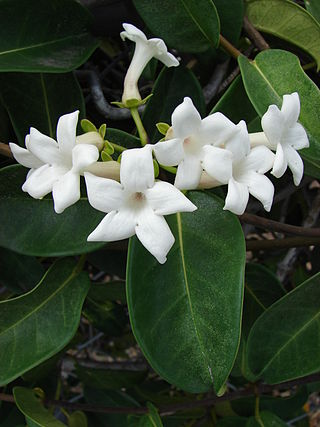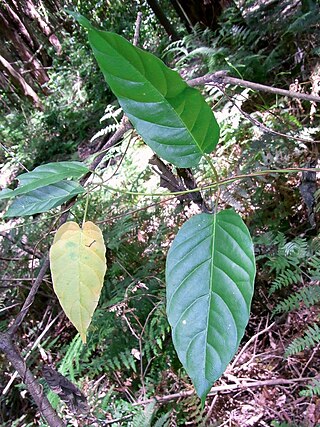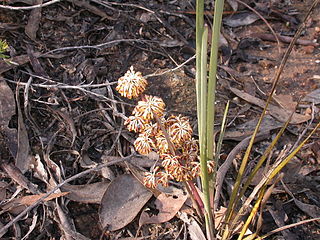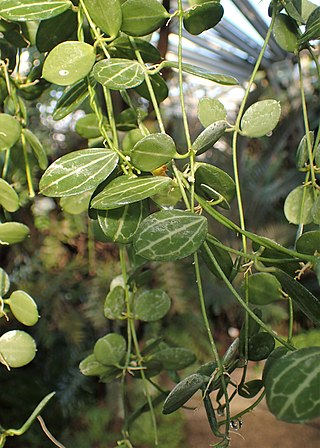
The Asclepiadoideae are a subfamily of plants in the family Apocynaceae. Formerly, they were treated as a separate family under the name Asclepiadaceae, e.g. by APG II, and known as the milkweed family.
Stylidium muscicola is a dicotyledonous plant that belongs to the genus Stylidium that was described by Ferdinand von Mueller in 1859. It is an erect annual plant that grows from 5 to 33 cm tall. Obovate or orbicular leaves, about 4-20 per plant, form terminal rosettes with some scattered along the stems. The leaves are generally 6–33 mm long and 5–28 mm wide. This species generally has one to eight scapes and cymose inflorescences that are 3–17 cm long. Flowers are white, pink, or mauve. S. muscicola's native range is concentrated in and around western Kimberley in Western Australia and extends to the northern parts of the Northern Territory and east almost to Queensland. Its typical habitat is a sheltered area along a sandstone ridge in sandy soils that remain moist in the dry seasons. It flowers in the southern hemisphere from February to September.

Macrozamia mountperriensis is a species of plant in the family Zamiaceae endemic to the area around Mount Perry in Queensland; however, it is not considered threatened due to its large population in the area. The species was discovered by colonial botanists including Frederick Manson Bailey and James Keys in the late 1800s. All members of the Zamiaceae family are considered to be poisonous.

Marsdenia is a genus of plants in the family Apocynaceae first described as a genus in 1810. It is named in honor of the plant collector and Secretary of the Admiralty, William Marsden. The plants are native to tropical regions in Asia, Africa, Australia, and the Americas.

Parsonsia is a genus of woody vines in the family Apocynaceae. Species occur throughout Indomalaya, Australasia and Melanesia.

Austrosteenisia is a genus of flowering plants in the family Fabaceae. It belongs to the subfamily Faboideae. It includes four species native to New Guinea and eastern Australia.
Anthony Russell Bean is an Australian botanist who works at the Queensland Herbarium and Brisbane Botanic Gardens, Mount Coot-tha. Since 1982, he has led the Eucalyptus Study Group of the Society for Growing Australian Plants.

Leichhardtia suaveolens, synonym Marsdenia suaveolens, commonly known as the scented milk vine, is a small vine found in New South Wales, Australia. It is found in a variety of habitats in relatively high rainfall areas, from Bega to Port Macquarie. The original specimen was collected at Sydney on 11 May 1802.

Leichhardtia flavescens, synonym Marsdenia flavescens, is a vine found in eastern Australia. Common names include hairy milk vine, yellow milk vine and native potato.

Leichhardtia rostrata, synonym Marsdenia rostrata, is a common climbing plant found in eastern Australia. This member of the dogbane family features white milky sap, when leaves are broken from the stem. It is found in a variety of habitats in relatively high rainfall areas, including rainforest and wet eucalyptus forest. Widespread in distribution in coastal regions, though it also appears inland in places such as the Liverpool Range. It may grow to ten metres tall, with a woody stem up to 4 cm wide. Leaves range from 4 to 13 cm long and 2 to 7 cm wide. The fruit is somewhat pear shaped, 5 cm by 2.5 cm.
Leichhardtia tubulosa is a species of plant of unknown habit in the dogbane family, first described by Ferdinand von Mueller in 1875 as Marsdenia tubulosa. It is endemic to Australia's subtropical Lord Howe Island in the Tasman Sea. It is known only from a single collection, made in 1871 on the summit of Mount Gower, and is believed to be extinct.

Lomandra multiflora, also commonly known as many-flowered mat rush, mat rush and many flowered mat-lily, is a perennial, rhizomatous herb found in Australia and Papua New Guinea. The mat rush is distributed widely in the region and common within its preferred growing conditions. Its conservation status is considered not to be of concern and risk.

Leichhardtia lloydii, synonym Marsdenia lloydii, is a climbing plant found in eastern Australia. It is known as the corky marsdenia. This member of the dogbane family exudes white sap when leaves are broken from the stem. The stems have a white fissured corky covering. This plant is found in and around drier rainforest areas, north from Gloucester, New South Wales.
Leichhardtia mackeeorum, synonym Marsdenia mackeeorum, is a species of vine in the family Apocynaceae. It is endemic to New Caledonia.
Paul Irwin Forster is an Australian botanist. He obtained his doctorate from the University of Queensland in 2004 with his thesis The pursuit of plants : studies on the systematics, ecology and chemistry of the vascular flora of Australia and related regions.
Sally T. Reynolds is an Australian botanist.

Acacia hylonoma, commonly known as Yarrabah wattle, is a shrub of the genus Acacia and the subgenus Plurinerves that is endemic to a small area of north eastern Australia.

Clematicissus angustissima is a vine in the Vitaceae family, endemic to the Geraldton area of Western Australia.

Dischidia ovata, commonly called watermelon dischidia, is a small vine in the frangipani and hoya family Apocynaceae, native to New Guinea and Cape York Peninsula, Australia. The species name ovata refers to its ovate leaves, its common name refers to the leaf venation that resembles a watermelon rind. The species is succulent and grows as an epiphytic or lithophytic vine in a variety of habitats.

Leichhardtia is a genus of flowering plants in the dogbane family (Apocynaceae). It includes 85 species native to mainland Australia, Papuasia, New Caledonia, and Lord Howe Island.














